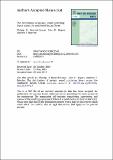The distribution of pelagic sound scattering layers across the southwest Indian Ocean
Date
02/2017Metadata
Show full item recordAbstract
Shallow and deep scattering layers (SLs) were surveyed with split-beam echosounders across the southwest Indian Ocean (SWIO) to investigate their vertical and geographical distribution. Cluster analysis was employed to objectively classify vertical backscatter profiles. Correlations between backscatter and environmental covariates were modelled using generalized additive mixed models (GAMMs) with spatial error structures. Structurally distinct SL regimes were found across the Subantarctic Front. GAMMs indicated a close relationship between sea surface temperature and mean volume backscatter, with significantly elevated backscatter in the subtropical convergence zone. The heterogeneous distribution of scattering layer biota reflects the biogeographic zonation of the survey area and is likely to have implications for predator foraging and carbon cycling in the Indian Ocean.
Citation
Boersch-Supan , P H , Rogers , A D & Brierley , A S 2017 , ' The distribution of pelagic sound scattering layers across the southwest Indian Ocean ' , Deep Sea Research Part II: Topical Studies in Oceanography , vol. 136 , pp. 108-121 . https://doi.org/10.1016/j.dsr2.2015.06.023
Publication
Deep Sea Research Part II: Topical Studies in Oceanography
Status
Peer reviewed
ISSN
0967-0645Type
Journal article
Description
Ship of Opportunity Data were sourced from the Integrated Marine Observing System (IMOS)—an initiative of the Australian Government being conducted as part of the National Collaborative Research Infrastructure Strategy and the Super Science Initiative. Other acoustic data were collected as part of the Southwest Indian Ocean Seamounts Project (http://www.iucn.org/marine/seamounts) which was supported supported by the EAF Nansen Project, the Food and Agriculture Organization of the United Nations, the Global Environment Facility, the International Union for the Conservation of Nature, the Natural Environment Research Council (Grant NE/F005504/1), the Leverhulme Trust (Grant F00390C) and the Total Foundation. We thank the Masters, officers, crews and science parties of cruises DFN 2009-410 and JCO66/67 for their assistance during echosounder calibration and data acquisition, and two anonymous reviewers for their comments. PHBS was supported by the German National Academic Foundation, a Cusanuswerk doctoral fellowship, and a Lesley & Charles Hilton-Brown Scholarship.Collections
Items in the St Andrews Research Repository are protected by copyright, with all rights reserved, unless otherwise indicated.

